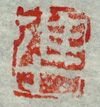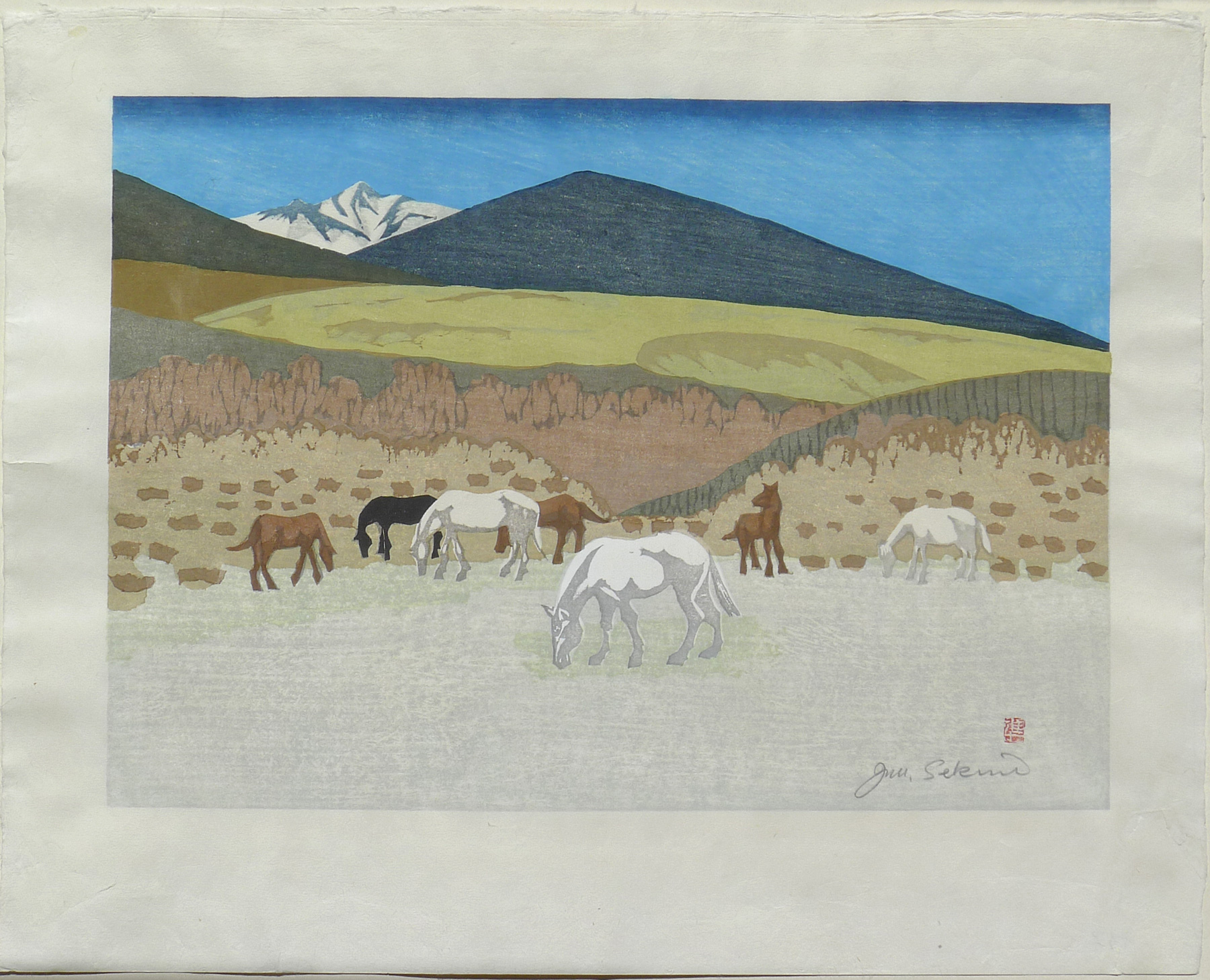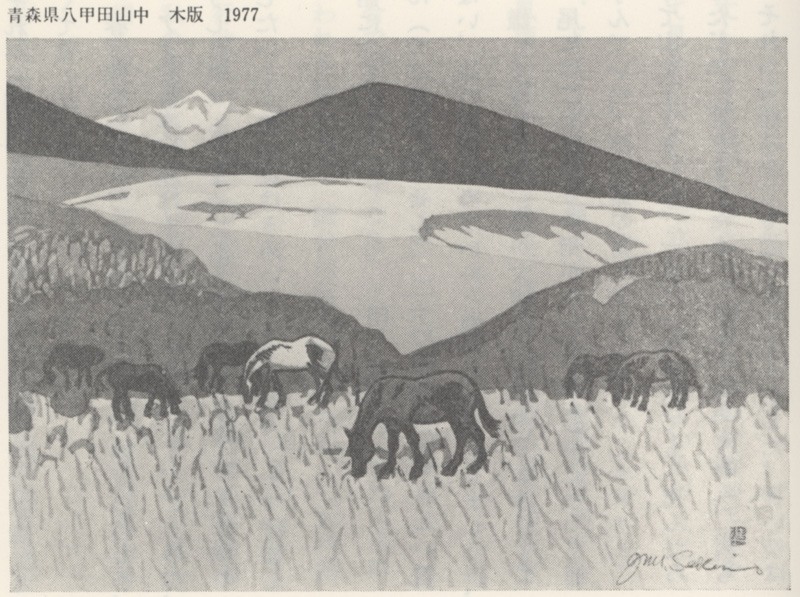About This Print
The Portland Art Museum, which owns an impression of this Sekino scene of horses grazing in the foothills of a mountain range, notes in their 2011 catalog of the exhibition "The Artist's Touch, The Craftsman's Hand," that "no other known impressions" of this print exist. However, subsequent to the compilation of the catalog, two other impressions of this print surfaced - this collection's impression and one offered by the German auction house Artelino.
While the Portland Art Museum's print, which I have viewed, is accompanied by a hand written notation by Dr. Gordon Gilkey, curator, professor, print maker and donator of this print (along with so many others) to the museum, titling the print Oregon Coast Range, the Artelino print carries the hand written title "萱野高原" (Kayano Kogen) on the lower left margin of the print, which translates into English as Kayano Plateau. (The Kayano Plateau sits below the Hakkoda mountains in Aomori prefecture. It is at the level of 540 meters, and is covered with natural lawn.)1 This collection's print carries no title (although there is an indecipherable notation on the verso.) I can imagine Dr. Gilkey, who was a friend of Sekino's and instrumental in bringing him to Oregon State University to teach print making, asking Sekino about the print and mentioning that it looked like the Oregon Cascade Range and that somehow being transcribed as the print's title.
While perusing the book Kaidō kōryo, Sekino Jun'ichirō gabunshū (Travels Along Highways: Illustrations and Text by Sekino Jun'ichirō), a book published by Bijutsu Shuppansha in 1983, I noticed on page 41, as shown below, a modified impression of this print with the title Aomori-ken Hakkōda sanchū (In the Hakkōda Mountains of Aomori Prefecture), 1977. For this re-titled print, Sekino covered the most distant peak and the green bluffs of the middle ground with snow; added tall grasses in the foreground; changed the color of the horses, and made other adjustments to the low-lying hills.
1 http://www.travel-around-japan.com/k21-04-hakkoda.html
Catalog entry from The Artist's Touch, The Craftsman's Hand: Three Centuries of Japanese Prints from the Portland Art MuseumSource: The Artist's Touch, The Craftsman's Hand: Three Centuries of Japanese Prints from the Portland Art Museum, Maribeth Graybill, Portland Art Museum, Oregon, 2011, p. 307.
| Like Munakata [Munakata Shikō, 1903-1975], Sekino Jun'ichiro was originally from Aomori in northern Japan. When the Sekino family moved to Tokyo, it was to the same neighborhood as Munakata, and Sekino grew up padding after Munakata's steps in his studio. His lifelong reverence for the senior printmaker is apparent in his portrait of Munakata. Later, he found another mentor in Onchi Kōshirō, and worked closely with him for fifteen years. Less well known is the importance he attached to the time he spent in Corvallis, Oregon. Gordon Gilkey, on the faculty of the Art Department at Oregon State University, invited Sekino to teach as a visiting artist for a year. Gilkey pushed him to experiment with new techniques and shared his vast personal collection of contemporary prints from around the world. Sekino gave Gilkey many of his prints and printed books. Inside one of the books he tucked a pencil drawing in which he portrays himself bowing deeply go Gilkey, with the caption, "Think you very much [sic]." Gilkey later became curator of prints and drawings at the Portland Art Museum, and he donated sixty-two works by Sekino to the Museum. This print, dating from Sekino's teaching stint at OSU, is a fine example of how the artist loved to work with flat blocks of color and tint overlays to create his forms. |
Print Details
| IHL Catalog | #769 |
| Title | Kayano Plateau 萱野高原 (Portland Art Museum titles this print "Oregon Cascade Range," but see discussion above.) |
| Series | none |
| Artist | Sekino Jun’ichirō (1914 - 1988) |
| Signature |  |
| Seal |  |
| Publication Date | 1963 |
| Edition | first and only |
| Publisher | self-published |
| Carver | self-carved |
| Printer | printed by one of the artist's studio printers |
| Impression | excellent |
| Colors | excellent |
| Condition | excellent - handling/printing creases and very minor paper flaws in margin |
| Genre | sosaku hanga (creative print) |
| Miscellaneous | the lower right corner on the back of the print bears the following hand written notation: Possibly a date followed by the kanji characters 下冬, but two readers of Japanese have found this notation indecipherable. Possibly a date followed by the kanji characters 下冬, but two readers of Japanese have found this notation indecipherable. |
| Format | dai oban |
| H x W Paper | 17 x 21 1/2 in. (43.2 x 54.6 cm) |
| H x W Image | 12 5/8 x 17 7/8 in. (32.1 x 45.4 cm) |
| Collections This Print | Portland Art Museum 83.57.221 |
| Reference Literature | |



